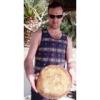
Home baking in late July, and September 2010
The lecturing schedule kicks off in earnest tomorrow, following Induction sessions this past 2 weeks to enable our students to find their way and settle in at the College.
I noted the freezer stock of bread at home, piled high before we went to Crete, was virtually empty, so set up to do some baking over this weekend.
I borrowed "Advanced Bread and Pastry" by Michel Suas from the College Library as essential reading for the Summer, in order to plan to run a Level 3 ["A" Level] course this year. It seems to be a ready-made textbook, especially given that Cengage [publishers] offer excellent online support for both instructor and student.
The breads I made just before our holiday utilised the Mountain Bread recipe, moreorless straight from the book. I really enjoy making a couronne shape; these were lovely, with a formula very similar to the Pain de Siègle recipe I use in class with students, but omitting the fresh yeast in the final dough.
I also made some of the "Wonderful White", which I posted on at the back end of last year, when I first happened upon TFL. You can read about that here: http://www.thefreshloaf.com/node/15974/sour-dough-leaven-refreshment-and-ash-content#comment-102650
Yesterday [Saturday] I mixed 2kg of paste to make Horst Bandel's Black Pumpernickel in a Pullman Pan. These are the links to the formulae: http://www.thefreshloaf.com/node/17254/horst-bandel039s-balck-pumpernickel and http://www.thefreshloaf.com/node/17931/horst-bandel039s-black-pumpernickel
Except that I used strong white flour in the final paste this time, so the formula is as Hamelman recommends, with the additional controls on water I added as constant. This was then baked very slowly overnight in my regular electric [fan] oven, at 100°C, with a small tray of water for a steady steam supply. I did share this earlier with Nico to ascertain a bake profile. I still like to steam these loaves, and intend to revert to this method in the ovens at College [Pumpernickel now on the student syllabus!]. The end result was very acceptable, with Alison asking for more at lunchtime, when I really should have been insisting on waiting a couple more days before slicing. We just love rye in this house! Photos:
And I made 3 x 1200+g loaves of Pain de Campagne. The leaven had one feed from stock beforehand as refreshment and to re-invigorate activity.
New journey for me this time round: overnight retarding! I've done this before commercially and whilst running bread courses, but not at home. It worked well, I did 3 variations, and think the last loaf gave the best results. Loaf 1 had only 1½ hours final proof [too tight in the baking]; loaf 2, radically, I did not re-mould [good, but a bit flat and rustic] and loaf 3 instructions given below, with photographs attached.
Great finished bread taste and texture too!
This is the formula:
|
Material |
Formula [% of flour] |
Recipe [grams] |
|
|
|
|
Levain |
Flour: 12.4. Water: 7.5. TOTAL 19.9 |
Flour: 280. Water: 168. TOTAL 448 |
|
Strong White Flour |
18.65 |
420 |
|
Water |
11.2 |
252 |
|
TOTAL |
49.7 |
1120 |
|
|
|
|
|
|
|
|
Dark Rye Flour |
2.15 |
50 |
|
Water |
2.15 |
50 |
|
TOTAL |
4.3 |
100 |
|
|
|
|
|
|
|
|
Leaven [from above] |
49.7 |
1120 |
|
Rye Sour [from above] |
4.3 |
100 |
|
Strong White Flour |
63.8 |
1435 |
|
Dark Rye Flour |
3 |
65 |
|
Salt |
1.78 |
40 |
|
Water |
47.1 |
1060 |
|
TOTAL |
169.68 |
3820 |
|
Total Pre-fermented flour |
33% |
|
|
Total Hydration |
68% |
|
Bake Profile: Steam, pre-heated oven [250°C], baking on hot bricks, drop heat to 200°C after 20 minutes. Total Bake Time of 40 - 45 minutes
Method:
- Autolyse flours, water and rye sour for 1 hour.
- Add leaven to form a dough and mix by hand for 5 minutes.
- Add salt and mix a further 5 minutes. Rest briefly
- Complete mixing cycle, using "slapping" techniques.
- Bulk ferment for 2½ hours; S&F every 45 minutes.
- Scale and divide into 3 equal pieces, and mould each round.
- Line plastic bowls with a little olive oil and use these to store dough pieces overnight, covered, in the fridge [mine was running <4°C].
- Take each dough piece out as required and re-mould.
- Drop upside down into a prepared banneton and set to prove for 2 hours, covered with heavy plastic
- Turn out the dough piece onto a pre-heated metal sheet, cut as desired and bake to the profile shown above.
Best wishes to you all
Andy


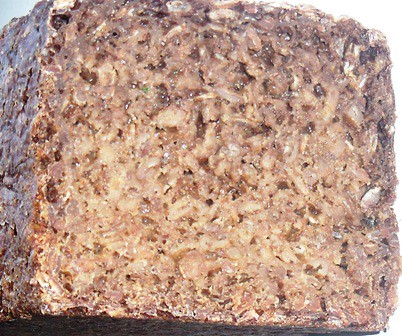
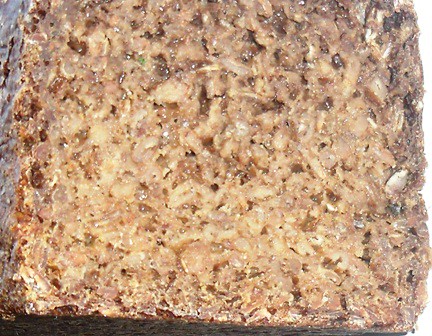

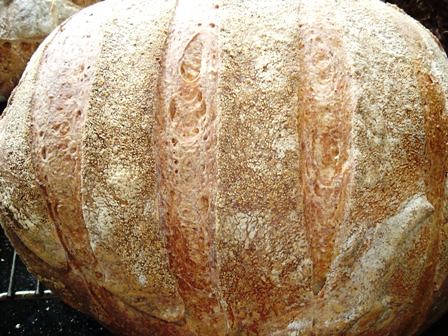


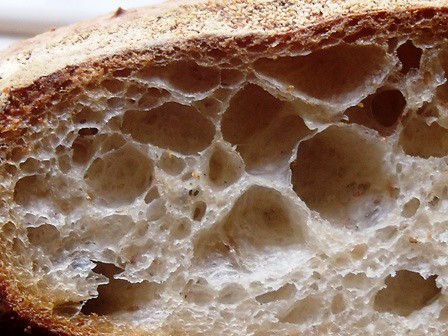


Comments
Good to see you back at it Andy. Beautiful breads as usual. You sure get a nice crumb from the Pain au Levain.
Eric
In so many ways Eric...
lectures, studying for MSc etc etc.
Pumpernickel...definitely needs steaming for me.
Are you still on sabbatical from baking yourself? It's really good to hear from you
BW
Andy
David
Many Thanks David,
Further to your recent thread on wholewheat bread which I've just commented on.
I think I would like to increase the Dark Rye in the Pain au Levain to nearer 10%. I'm really happy with this loaf, but I reckon it would take the increased wholegrain, whether added as sour or not.
BW
Andy
Wonderful baking and great write-up Andy!
I realised how you took a photo of your recipe as a spreadsheet. That's neat. Do you then upload it separately to TFL with a link?
I see your holiday has had only positive influence on your baking...as should always be the case!
Best wishes
Andy
Thanks Andy!
Yes, I make a screenshot and save it as a .jpg file. Upload that to TFL as usual, and then insert a link to it.
Nice bake, especially the crumb on the last one! Exemplary Bake, andy..
khalid
Many thanks Khalid,
I feel your posts of largely wholegrain leavens, clearly inspired by Jeffrey Hamelman, have been driving the breadmaking standards on TFL to new levels lately. I know you set your sights very high; just to echo that I find your own bread to be just as exemplary to me.
Best wishes
Andy
Your bread, as always, makes me want hop on the next jet to Newcastle so I can actually taste it instead of just looking at it.
The Pain de Campagne has such a good cell structure, crust, and volume to it, it's really a benchmark for the the rest of us to try and achieve. It must be almost a knockoff for you by now though. Fabulous!
Horst Bandel's Pumpernickel is something I've wanted to try since I first read the formula in 'Bread', and have followed your posts as well as others in trying to get a better understanding of this bread. I'm wondering, did the colour darken any further after you sliced it? How was it on day 2 ? To tell you the truth I'm not a huge fan of any pumpernickel I've tasted so far, but the Bandel formula seems to be the real thing . I'd like to get a result similar to yours just so I know what real pumpernickel should taste like. This one you've made just looks excellent! Nice work my friend.
Best Wishes,
Franko
Thanks very much for your kind words Franko.
I don't really do "knock-offs" at home; don't think Alison would settle for that, nor me, come to think of it!
A question I wanted to ask all of you was to ask for further thoughts on overnight retard techniques.
Khalid, this is very much you territory, no? Do you shape and store in bannetons? I used lightly oiled plastic bowls...then gently re-moulded in the morning, and proofed in the banneton prior to baking. I'm really pleased with the taste...not too sour at all.
Franko, yes, do the HB, it's wicked. But find a way to steam the bread, rather than bake it. It's too dry. On the colour front, I don't think my photographs really do justice to how dark the loaf is. That said, I've seen some posters loaves much darker. I'm happy with the intensity of colour I've achieved thus far. Nico sets the benchmark in this particular colour field, for sure.
Re appreciating Pumpernickel, this is the key to me. It needs a rye sour and a sweetener such as molasses. The bulk should consist of a combination of fresh flour, cracked grain, cooked wholegrain and altus. I really hope you come to appreciate these fine qualities.
Thanks again for your comments, it's great to hear from you
Andy
I've been away on vacation Andy, and then too busy to follow things here at TFL for awhile, but saw your post and wanted to comment. Lovely looking rye (I got a bit too aggressive with hydration with one today and watched it collapse - oh well, that's how we learn how far to venture, no?). The crumb on your pain au levain is really exceptional.
Back to the grind for you - but at least at the end of the day there's some decent bread to be consumed.
Best-
Larry
Hi Larry,
Hope you had a great vacation..where did you go?
Yep, rye flour can be really thirsty..but those pentosans become really unstable late in the proof, and in the ove, don't they?
Best wishes
Andy
Hi Andy,
I was looking for a new post from you the last few weeks - it's getting difficult to find what you search in the middle of 60/70 other posts that are now the daily mail from TLF, I almost gave up and took my name of the list -
I always learn something from your posts and your photos are visible on my computer when most of the other posts' photos won't open(I have win7).
I wish you a good teaching year with a lot of summits. Last term I began to give French conversation courses and I get an incredible satisfaction from it, more than I expected. I wish I could be living close to Newcastle UK instead to Newcastle downunder and be able to learn at your college ( I probably should also wish to be seriously younger for that).
I made a TFL acquaintance and will tell her the names of the bunch of tremendous great bakers she can find on the site. Cheers, Bea
Hi Bea,
Not heard from you in a while, many thanks for posting here.
Why don't you type "ananda" into the search box on the top left of the screen? There should be something which comes up which will take you into my blog.
Very heavy site traffic at TFL these days, I agree. But don't opt out...just think about how much you'll miss; we'd miss your contribution too.
Best wishes
andy
Thanks, Andy! I'am surprised how you praise my bakes, i only started with Hamelman's book months ago, so i have loads to learn. But thanks anyway!! I appreciate any encouragement, especially from you. The thing is, i am an amateur sketcher/painter, and can't seem to produce anything short of "visually attractive", even if the process is painstaking.
As to the retardation, i have only ;ately ventured into it. I'am still learning,
Khalid
Wonderful breads, Andy.
Love the striped effect on the Pain de Campagne.
You sure keep busy!
Many thanks Lindy,
That's the lovely coarse semolina I buy from the local mill.
Misting the loaf tops as they went in the oven really helped too
Best wishes
Andy
These breads look great....I can never get that open crumb...no idea how that happens, followed instructions but still does not happen.
I have a question for the experts. Just before I put my bread in the hot oven it is well-risen but during baking it flattens and I always wonder what happen to that lovely rise...so what happens to it? I let it rise for 3-4 hours then after shaping I let it rise above the pans then bake in hot oven for 20-30 minutes depending on the wetness of the dough...... is that over proofing?
I usually make bread with a starter that I keep going...sometimes it's bubbly sometimes not but always sour. I mix wheat and plain bread flour and use salt and no oil or sugar and very small of yeast at times too.
So, I welcome your feedback about what I am doing wrong though I have to say the bread stiil tastes good and the really has a good crunch and crumb is not bad looking....sorry can't post photos yet....need to learn how to!
Thanks, all!
Cynthia in Hong Kong
Hi Cynthia,
Giving times will only ever be a guide as to when the bread is ready to go into the oven. It is important for you to learn to judge the levels of proof on your bread. Only gained through the experience of actually doing it, unless you can have an expert on hand at the time...unlikely.
People on here sometimes refer to the "poke" test, although I don't really like that phrase. I recommend that you gently press on the surface of the dough using the soft pad of your index finger. If the dough is collapsing and doesn't spring back, then it is over-proved. If it springs straight back, then it needs further proof before baking. Your finger imprint should gradually return and disappear if the loaf is ready.
From your description, you are definitely over-proving your bread. You should be looking for spring in the oven, where your dough is collapsing. Hope this helps.
Many thanks for your kind comments
Andy
Thanks, Ananda....your tips were very helpful!
I have a 'stout' sour bread proofing right now and will try to get the 'rise' right and will keep you all on this site updated of my success or not.....
Cynthia
Hi Cynthia,
Posting photographs always makes it much easier to diagnose faults, if you are able to?
BW
Andy